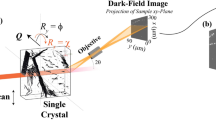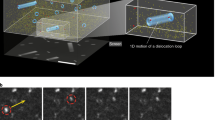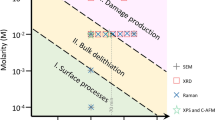Abstract
TRANSMISSION electron microscopy of thin foils, as developed by Hirsch, Whelan and co-workers1, has become an important tool in studying the static1,2 and kinetic3 behaviour of dislocations in metals. Very few observations on non-metals have been published as yet. We have applied this technique to a number of non-metallic layer structures. One has then the advantage that very thin cleavage flakes can easily be prepared and, moreover, that the main glide plane usually coincides with the cleavage plane. In such cases extensive dislocation patterns will appear in the plane of observation. In particular, we have studied in some detail the following substances: bismuth telluride and antimony telluride, graphite, muscovite and talc. A few examples of patterns observed are reproduced in Figs. 1–3.
This is a preview of subscription content, access via your institution
Access options
Subscribe to this journal
Receive 51 print issues and online access
$199.00 per year
only $3.90 per issue
Buy this article
- Purchase on Springer Link
- Instant access to full article PDF
Prices may be subject to local taxes which are calculated during checkout
Similar content being viewed by others
References
For a review, see the contributions by Hirsch, P. B., and Whelan, M. J., J. Inst. Metals, 4, 385 (1959).
Whelan, M. J., Proc. Roy. Soc., A, 249, 114 (1958).
Berghezan, A., and Fourdeux, A., C.R. Acad. Sci., 248, 1333 (1959).
Author information
Authors and Affiliations
Rights and permissions
About this article
Cite this article
AMELINCKX, S., DELAVIGNETTE, P. Observation of Dislocations in Non-metallic Layer Structures. Nature 185, 603–604 (1960). https://doi.org/10.1038/185603a0
Issue Date:
DOI: https://doi.org/10.1038/185603a0
This article is cited by
-
Dynamic topological domain walls driven by lithium intercalation in graphene
Nature Nanotechnology (2023)
-
Unraveling the dislocation core structure at a van der Waals gap in bismuth telluride
Nature Communications (2019)
-
Distinct responses of nanostructured layered muscovite to uniform and nonuniform straining
Journal of Materials Science (2019)
-
Dislocations in bilayer graphene
Nature (2014)
-
Dissociated \( \frac{1}{3}\langle 0\bar{1}11\rangle \) 1 3 〈 0 1 ¯ 11 〉 dislocations in Bi2Te3 and their relationship to seven-layer Bi3Te4 defects
Journal of Materials Science (2014)
Comments
By submitting a comment you agree to abide by our Terms and Community Guidelines. If you find something abusive or that does not comply with our terms or guidelines please flag it as inappropriate.



